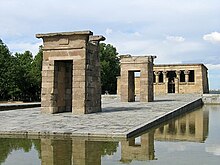This list of ancient Egyptian temples covers temples built by the ancient Egyptians from 3200 BC to 30 BC.
| Place name in Ancient Egyptian language (hieroglyphics) | Modern place name (country) Coordinates | Temple name | God of the temple | Date | Builder | Architectural style | Notes | Images | |||||
|---|---|---|---|---|---|---|---|---|---|---|---|---|---|
| pr-Wsỉr-Ḥp | Alexandria (Egypt) | Serapeum of Alexandria | Serapis | c. 246 – 222 BC [1] | Ptolemy III Euergete | Ptolemaic era |  | ||||||
| swnw | Kom Ombo (Aswan, Egypt) | Temple of Kom Ombo | Sobek | c. 180 – 47 BC [2] | The Ptolemaic dynasty | It was constructed during the Ptolemaic dynasty. [2] Some additions to it were later made during the Roman period. |  | ||||||
| waset | Luxor (Egypt) | Temple of Khonsu | Khonsu | c. 1186 – 1155 BC [3] | Ramesses III | New Kingdom temple | The edifice is an example of an almost complete New Kingdom temple, and was originally constructed by Ramesses III on the site of an earlier temple. [3] |  | |||||
| — | Originally: Near Aswan (Egypt) | Temple of Debod | Amun | c. 200 BC [4] | Adikhalamani (Tabriqo) | New Kingdom temple | The temple original location was 15 kilometres (9.3 mi) south of Aswan in Nubia, very close to the first cataract of the Nile. In the 20th century it was later dismantled as part of the International Campaign to Save the Monuments of Nubia and rebuilt in the center of Madrid, Spain, in Parque de la Montaña, Madrid, a square located Calle de Irún, 21–25 Madrid. [5] |  |